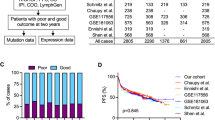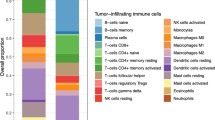Abstract
Gene expression profiles have been associated with clinical outcome in patients with diffuse large B-cell lymphoma (DLBCL) treated with anthracycline-containing chemotherapy. Using Affymetrix HU133A microarrays, we analyzed the lymphoma transcriptional profile of 30 patients treated with CHOP (cyclophosphamide, doxorubicin, vincristine, prednisone) and 23 patients treated with rituximab (R)-CHOP in the Groupe d'Etude des Lymphomes de l'Adulte clinical centers. We used this data set to select transcripts showing an association with progression-free survival in all patients or showing a differential effect in the two treatment groups. We performed real-time quantitative reverse transcription-PCR in the 23 R-CHOP samples of the screening set and an additional 44 R-CHOP samples set to evaluate the prognostic significance of these transcripts. In these 67 patients, the level of expression of 16 genes and the cell-of-origin classification were significantly associated with overall survival, independently of the International Prognostic Index. A multivariate model comprising four genes of the cell-of-origin signature (LMO2, MME, LPP and FOXP1) and two genes related to immune response, identified for their differential effects in R-CHOP patients (APOBEC3G and RAB33A), demonstrated a high predictive efficiency in this set of patients, suggesting that both features affect outcome in DLBCL patients receiving immunochemotherapy.
This is a preview of subscription content, access via your institution
Access options
Subscribe to this journal
Receive 12 print issues and online access
$259.00 per year
only $21.58 per issue
Buy this article
- Purchase on Springer Link
- Instant access to full article PDF
Prices may be subject to local taxes which are calculated during checkout


Similar content being viewed by others
Accession codes
References
Harris NL, Jaffe ES, Diebold J, Flandrin G, Muller-Hermelink HK, Vardiman J et al. World Health Organization classification of neoplastic diseases of the hematopoietic and lymphoid tissues: report of the Clinical Advisory Committee meeting-Airlie House, Virginia, November 1997. J Clin Oncol 1999; 17: 3835–3849.
Shipp MA, Harrington DP, Anderson JR, Armitage JO, Bonadonna G, Brittinger G et al. A predictive model for aggressive non-Hodgkin's lymphoma. The International Non-Hodgkin's Lymphoma Prognostic Factors Project. N Engl J Med 1993; 329: 987–994.
Lossos IS . Molecular pathogenesis of diffuse large B-cell lymphoma. J Clin Oncol 2005; 23: 6351–6357.
Alizadeh AA, Eisen MB, Davis RE, Ma C, Lossos IS, Rosenwald A et al. Distinct types of diffuse large B-cell lymphoma identified by gene expression profiling. Nature 2000; 403: 503–511.
Rosenwald A, Wright G, Chan WC, Connors JM, Campo E, Fisher RI et al. The use of molecular profiling to predict survival after chemotherapy for diffuse large-B-cell lymphoma. N Engl J Med 2002; 346: 1937–1947.
Monti S, Savage KJ, Kutok JL, Feuerhake F, Kurtin P, Mihm M et al. Molecular profiling of diffuse large B-cell lymphoma identifies robust subtypes including one characterized by host inflammatory response. Blood 2005; 105: 1851–1861.
Shipp MA, Ross KN, Tamayo P, Weng AP, Kutok JL, Aguiar RC et al. Diffuse large B-cell lymphoma outcome prediction by gene-expression profiling and supervised machine learning. Nat Med 2002; 8: 68–74.
Lossos IS, Czerwinski DK, Alizadeh AA, Wechser MA, Tibshirani R, Botstein D et al. Prediction of survival in diffuse large-B-cell lymphoma based on the expression of six genes. N Engl J Med 2004; 350: 1828–1837.
Coiffier B, Lepage E, Briere J, Herbrecht R, Tilly H, Bouabdallah R et al. CHOP chemotherapy plus rituximab compared with CHOP alone in elderly patients with diffuse large-B-cell lymphoma. N Engl J Med 2002; 346: 235–242.
Feugier P, Van Hoof A, Sebban C, Solal-Celigny P, Bouabdallah R, Ferme C et al. Long-term results of the R-CHOP study in the treatment of elderly patients with diffuse large B-cell lymphoma: a study by the Groupe d'Etude des Lymphomes de l'Adulte. J Clin Oncol 2005; 23: 4117–4126.
Coiffier B . State-of-the-art therapeutics: diffuse large B-cell lymphoma. J Clin Oncol 2005; 23: 6387–6393.
Smith MR . Rituximab (monoclonal anti-CD20 antibody): mechanisms of action and resistance. Oncogene 2003; 22: 7359–7368.
Cartron G, Watier H, Golay J, Solal-Celigny P . From the bench to the bedside: ways to improve rituximab efficacy. Blood 2004; 104: 2635–2642.
Friedberg JW . Unique toxicities and resistance mechanisms associated with monoclonal antibody therapy. In: Gerwitz AM, Winter JN, Zuckerman K (eds). Hematology (Am Soc Hematol Educ Program). American Society of Hematology Inc.: Washington DC, 2005, pp 329–334.
Mounier N, Briere J, Gisselbrecht C, Emile JF, Lederlin P, Sebban C et al. Rituximab plus CHOP (R-CHOP) overcomes bcl-2—associated resistance to chemotherapy in elderly patients with diffuse large B-cell lymphoma (DLBCL). Blood 2003; 101: 4279–4284.
Winter JN, Weller EA, Horning SJ, Krajewska M, Variakojis D, Habermann TM et al. Prognostic significance of Bcl-6 protein expression in DLBCL treated with CHOP or R-CHOP: a prospective correlative study. Blood 2006; 107: 4207–4213.
Irizarry RA, Hobbs B, Collin F, Beazer-Barclay YD, Antonellis KJ, Scherf U et al. Exploration, normalization, and summaries of high density oligonucleotide array probe level data. Biostatistics (Oxford, England) 2003; 4: 249–264.
Gentleman R, Ihaka R, the R Development Core Team. R: A Language and Environment for Statistical Computing—Reference Manual. R Foundation for Statistical Computing: Vienna, Austria, 2007, 1–1507.
Gentleman RC, Carey VJ, Bates DM, Bolstad B, Dettling M, Dudoit S et al. Bioconductor: open software development for computational biology and bioinformatics. Genome Biol 2004; 5: R80.
Kalbfleisch JD, Prentice RL . Relative risk (Cox) regression models. In: Kalbfleisch JD, Prentice RL (eds). The Statistical Analysis of Failure Time Data, 2nd edn. John Wiley & Sons Inc.: Hoboken, NJ, 2002, pp 95–147.
Tibshirani R . Regression shrinkage and selection via the lasso. J R Statist Soc B 1996; 58: 267–288.
Park MY, Hastie T . L1-regularization path algorithm for generalized linear models. J R Statist Soc B 2007; 69: 659–677.
Harrell Jr FE, Lee KL, Mark DB . Multivariable prognostic models: issues in developing models, evaluating assumptions and adequacy, and measuring and reducing errors. Stat Med 1996; 15: 361–387.
Wright G, Tan B, Rosenwald A, Hurt EH, Wiestner A, Staudt LM . A gene expression-based method to diagnose clinically distinct subgroups of diffuse large B cell lymphoma. Proc Natl Acad Sci USA 2003; 100: 9991–9996.
Barrans SL, Fenton JA, Banham A, Owen RG, Jack AS . Strong expression of FOXP1 identifies a distinct subset of diffuse large B-cell lymphoma (DLBCL) patients with poor outcome. Blood 2004; 104: 2933–2935.
Segal MR . Microarray gene expression data with linked survival phenotypes: diffuse large-B-cell lymphoma revisited. Biostatistics (Oxford, England) 2006; 7: 268–285.
Skol AD, Scott LJ, Abecasis GR, Boehnke M . Joint analysis is more efficient than replication-based analysis for two-stage genome-wide association studies. Nat Genet 2006; 38: 209–213.
Zehetmayer S, Bauer P, Posch M . Two-stage designs for experiments with a large number of hypotheses. Bioinformatics 2005; 21: 3771–3777.
Hans CP, Weisenburger DD, Greiner TC, Gascoyne RD, Delabie J, Ott G et al. Confirmation of the molecular classification of diffuse large B-cell lymphoma by immunohistochemistry using a tissue microarray. Blood 2004; 103: 275–282.
Nyman H, Adde M, Karjalainen-Lindsberg ML, Taskinen M, Berglund M, Amini RM et al. Prognostic impact of immunohistochemically defined germinal center phenotype in diffuse large B-cell lymphoma patients treated with immunochemotherapy. Blood 2007; 109: 4930–4935.
de Jong D, Rosenwald A, Chhanabhai M, Gaulard P, Klapper W, Lee A et al. Immunohistochemical prognostic markers in diffuse large B-cell lymphoma: validation of tissue microarray as a prerequisite for broad clinical applications—a study from the Lunenburg Lymphoma Biomarker Consortium. J Clin Oncol 2007; 25: 805–812.
Natkunam Y, Farinha P, Hsi ED, Hans CP, Tibshirani R, Sehn LH et al. LMO2 protein expression predicts survival in patients with diffuse large B-cell lymphoma treated with anthracycline-based chemotherapy with and without rituximab. J Clin Oncol 2008; 26: 447–454.
Banham AH, Connors JM, Brown PJ, Cordell JL, Ott G, Sreenivasan G et al. Expression of the FOXP1 transcription factor is strongly associated with inferior survival in patients with diffuse large B-cell lymphoma. Clin Cancer Res 2005; 11: 1065–1072.
Chang CC, McClintock S, Cleveland RP, Trzpuc T, Vesole DH, Logan B et al. Immunohistochemical expression patterns of germinal center and activation B-cell markers correlate with prognosis in diffuse large B-cell lymphoma. Am J Surg Pathol 2004; 28: 464–470.
Fabiani B, Delmer A, Lepage E, Guettier C, Petrella T, Briere J et al. CD10 expression in diffuse large B-cell lymphomas does not influence survival. Virchows Arch 2004; 445: 545–551.
van Imhoff GW, Boerma EJ, van der Holt B, Schuuring E, Verdonck LF, Kluin-Nelemans HC et al. Prognostic impact of germinal center-associated proteins and chromosomal breakpoints in poor-risk diffuse large B-cell lymphoma. J Clin Oncol 2006; 24: 4135–4142.
Petit MM, Mols R, Schoenmakers EF, Mandahl N, Van de Ven WJ . LPP, the preferred fusion partner gene of HMGIC in lipomas, is a novel member of the LIM protein gene family. Genomics 1996; 36: 118–129.
Daheron L, Veinstein A, Brizard F, Drabkin H, Lacotte L, Guilhot F et al. Human LPP gene is fused to MLL in a secondary acute leukemia with a t(3;11) (q28;q23). Genes Chromosomes Cancer 2001; 31: 382–389.
Schwindt H, Akasaka T, Zuhlke-Jenisch R, Hans V, Schaller C, Klapper W et al. Chromosomal translocations fusing the BCL6 gene to different partner loci are recurrent in primary central nervous system lymphoma and may be associated with aberrant somatic hypermutation or defective class switch recombination. J Neuropathol Exp Neurol 2006; 65: 776–782.
Guo B, Sallis RE, Greenall A, Petit MM, Jansen E, Young L et al. The LIM domain protein LPP is a coactivator for the ETS domain transcription factor PEA3. Mol Cell Biol 2006; 26: 4529–4538.
Takaori-Kondo A . APOBEC family proteins: novel antiviral innate immunity. Int J Hematol 2006; 83: 213–216.
Gallois-Montbrun S, Kramer B, Swanson CM, Byers H, Lynham S, Ward M et al. Antiviral protein APOBEC3G localizes to ribonucleoprotein complexes found in P bodies and stress granules. J Virol 2007; 81: 2165–2178.
Stopak KS, Chiu YL, Kropp J, Grant RM, Greene WC . Distinct patterns of cytokine regulation of APOBEC3G expression and activity in primary lymphocytes, macrophages, and dendritic cells. J Biol Chem 2007; 282: 3539–3546.
Cheng E, Trombetta SE, Kovacs D, Beech RD, Ariyan S, Reyes-Mugica M et al. Rab33A: characterization, expression, and suppression by epigenetic modification. J Invest Dermatol 2006; 126: 2257–2271.
Jacobsen M, Repsilber D, Gutschmidt A, Neher A, Feldmann K, Mollenkopf HJ et al. Ras-associated small GTPase 33A, a novel T cell factor, is down-regulated in patients with tuberculosis. J Infect Dis 2005; 192: 1211–1218.
Acknowledgements
We are grateful to Fabien Petel (Ligue Nationale Contre le Cancer) for the management of the Affymetrix and annotation databases and submission of the same to the Array Express. We thank E Jacquet, H Lévaique, E Garrido (CNRS, Gif sur Yvette, France) and E Côme for the realization of the TLDA experiments; A Allain and N Nio for their help in clinical data management. We are indebted to the pathologists and clinicians of the GELA who contributed pathological specimen and clinical data. This study was supported by grants of the Ligue Nationale Contre le Cancer (programme Carte d'Identité des Tumeurs), the Programme Hospitalier de Recherche Clinique (AOM 03060) and an unrestricted grant from Roche.
Author information
Authors and Affiliations
Consortia
Corresponding author
Additional information
Supplementary Information accompanies the paper on the Leukemia website (http://www.nature.com/leu)
Rights and permissions
About this article
Cite this article
Jais, JP., Haioun, C., Molina, T. et al. The expression of 16 genes related to the cell of origin and immune response predicts survival in elderly patients with diffuse large B-cell lymphoma treated with CHOP and rituximab. Leukemia 22, 1917–1924 (2008). https://doi.org/10.1038/leu.2008.188
Received:
Revised:
Accepted:
Published:
Issue Date:
DOI: https://doi.org/10.1038/leu.2008.188
Keywords
This article is cited by
-
Isoform-specific knockdown of long and intermediate prolactin receptors interferes with evolution of B-cell neoplasms
Communications Biology (2023)
-
Smc3 dosage regulates B cell transit through germinal centers and restricts their malignant transformation
Nature Immunology (2021)
-
CRL3–SPOP ubiquitin ligase complex suppresses the growth of diffuse large B-cell lymphoma by negatively regulating the MyD88/NF-κB signaling
Leukemia (2020)
-
Application of Genomics to Clinical Practice in Haematological Malignancy
Current Genetic Medicine Reports (2019)
-
Emerging roles for LPP in metastatic cancer progression
Journal of Cell Communication and Signaling (2018)



